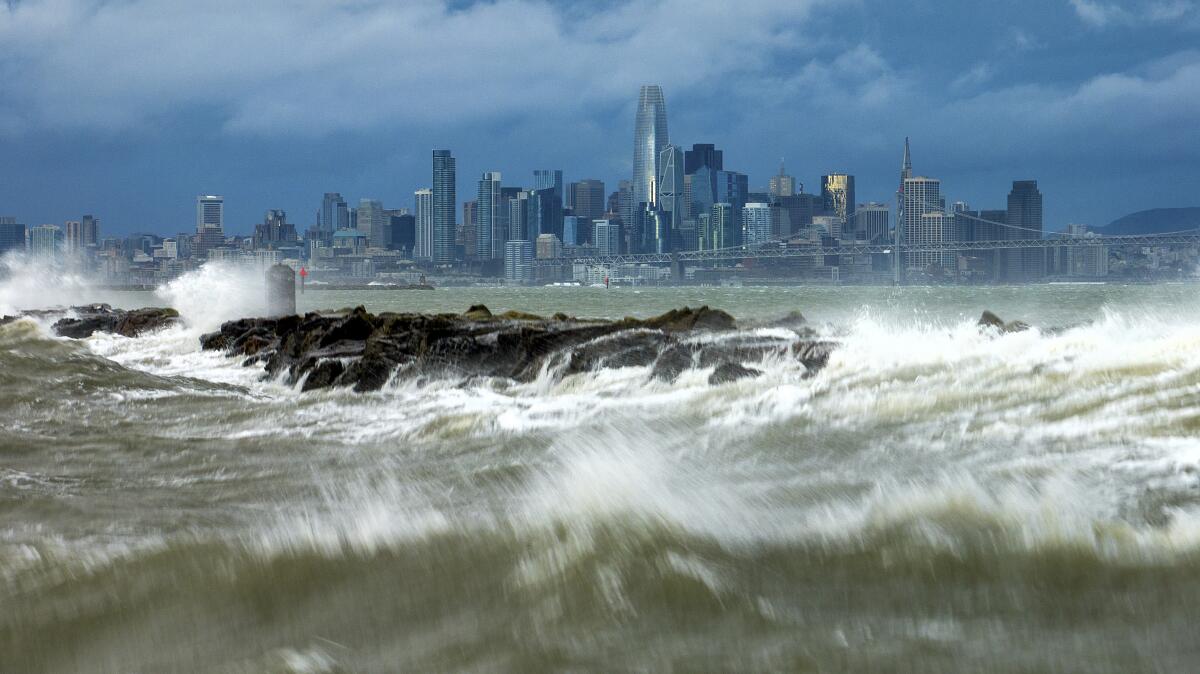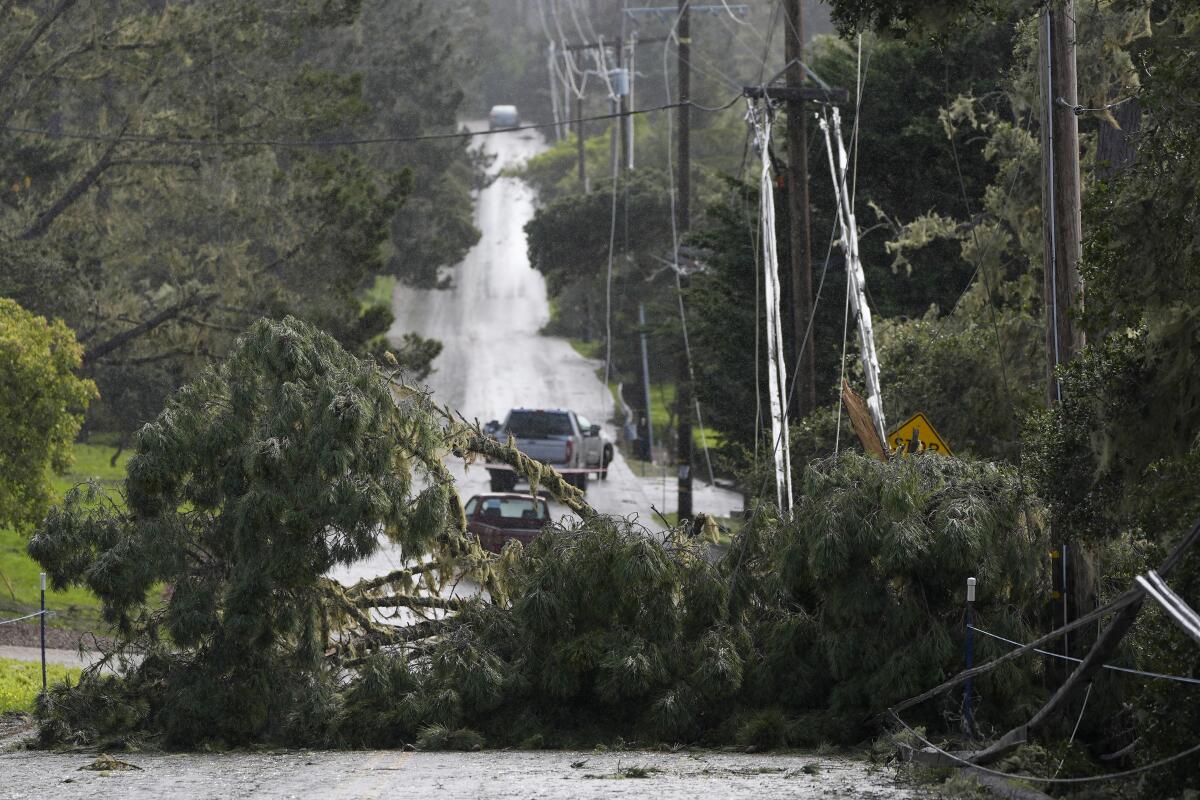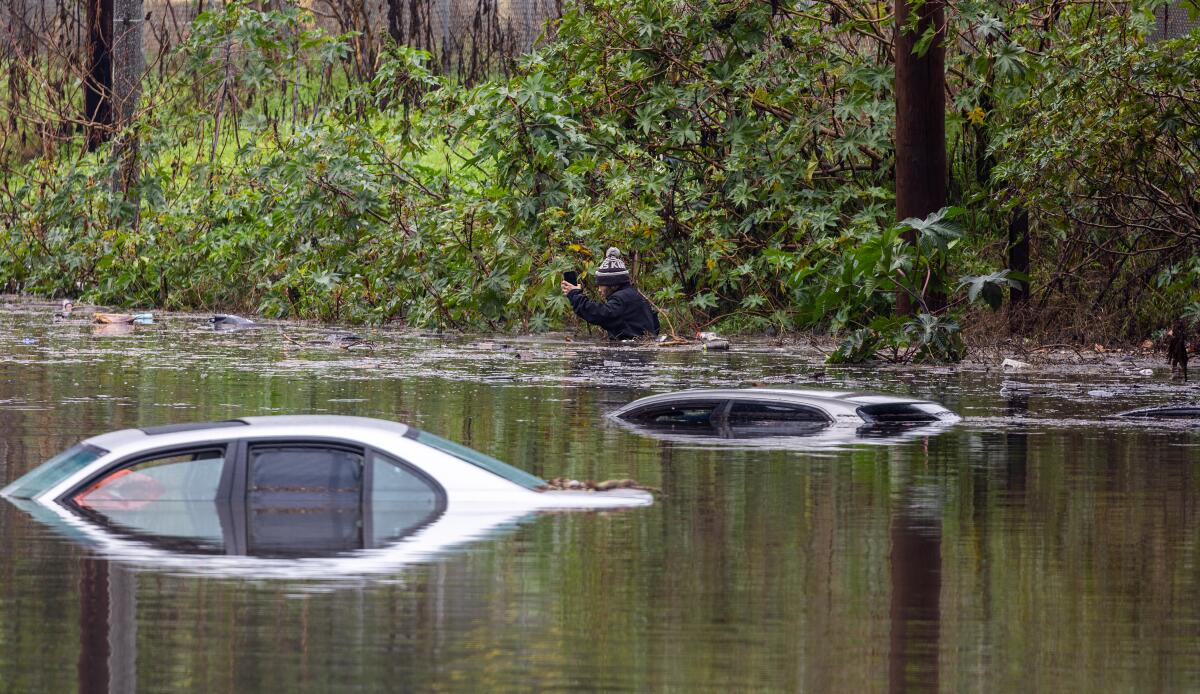Chilling rain, swirling gray clouds and blustery winds rolled into Southern California on Sunday as the strongest winter storm of the season geared up to deliver near-record rainfall and life-threatening flash flooding in the region through Tuesday.
The slow-moving atmospheric river was gathering strength Sunday afternoon, with the National Weather Service in Oxnard warning that “all systems are go for one of the most dramatic weather days in recent memory.”
Wind blown palm trees during a storm in Santa Barbara on Sunday. Hurricane-force winds battered the seas off California, while heavy rains raised flood risks from San Francisco to San Diego, as another powerful Pacific storm arrived.
(Bloomberg via Getty Images)
Forecasters said the brunt of the storm appeared focused on the Los Angeles area, where the system could park itself for an extended length of time over the next few days. The storm could drop up to 8 inches of rainfall on the coast and valleys, and up to 14 inches in the foothills and mountains. Snowfall totals of 2 to 5 feet are likely at elevations above 7,000 feet.
“Los Angeles County now seems to be the area of most concern, where the heaviest rain will last the longest,” said Ryan Kittell, a meteorologist with the NWS in Oxnard.
At the Ventura Harbor just north of L.A. County, rain was beating down on shops and restaurants that ordinarily draw tourists. It had been hours without a customer at Harbor Market and Liquor, and at a nearby hair salon, stylist Danielle White was weighing whether she should hit the road, worried that flooding could strand her there.
“We’re clearly not going to get any inquiries,” she said, gazing out at the rainfall.
The storm is expected to “bring a multitude of dangerous weather conditions to the area,” forecasters said. Evacuation warnings and notices were issued in portions of Ventura, Santa Barbara, Monterey and Los Angeles counties — including parts of Topanga near the Owen fire burn scar, and the La Tuna Canyon area of Sun Valley near the Land fire burn scar.
Burn scars are subject to an increased risk of flooding and debris flows, Mayor Karen Bass said in a statement. She urged Angelenos to heed all evacuation orders.
“Keeping people safe is our top priority, and in conditions like this, lives can be lost,” Bass said.
In addition to a high risk of flash flooding and excessive rainfall, the storm also has the potential to deliver damaging winds. That includes gusts of up to 70 mph in San Luis Obispo and Santa Barbara counties through 6 p.m. Sunday, with isolated gusts of up to 90 mph possible in mountain areas.
Ventura and Los Angeles counties could see wind gusts of up to 50 mph between 1 p.m. and 1 a.m., with isolated gusts of up to 70 mph in mountains and hills. The Ventura River is expected to swell and reach its flood stage around 11 p.m. Sunday night.
Inside Ventura’s Pierpont Tacos on Seaward Avenue, Joseph Kenton and Anna Tyler were taking a break from delivering firewood from Ojai on Sunday morning.
“People were freezing in this weather,” said Kenton, who had been out driving for hours making deliveries, between bites of his tacos. “They want wood to stay warm. Anna got up at 5 o’ clock and started splitting wood.”
As the rain started to fall, “it was real dangerous,” he said. “We had to go real slow.”
Kittell said the storm could make a mess of the Monday morning commute, including freeway flooding and major delays across L.A. County.
“If anyone has an opportunity to work remotely on Monday, that’s definitely the day to do it,” he said.

Waves crash over a breakwater in Alameda, Calif., with the San Francisco skyline in the background on Sunday. High winds and heavy rainfall are impacting the region.
(Noah Berger/AP)
The storm barreled through Northern and Central California before making its way south.
In Northern California, monster winds and downpours began to inundate the region late Saturday, with the worst of the weather kicking into high gear early Sunday. Thousands were without power by late morning, with officials scrambling to respond to downed trees and power lines across the Bay Area and Central Coast, as well as growing concerns about increased flooding.
Delays and cancellations at San Francisco International Airport led the nation Sunday morning, with almost a third of incoming and outgoing flights delayed as of noon Sunday, according to flight tracking website FlightAware.
Bob Rotiski, spokesperson for the airport, said the airport reduced its capacity for flights because of the weather, expecting continued delays through 1 a.m. Monday. He said the average flight was delayed more than 4 hours as of noon Sunday, with the possibility for that to increase.
In Sonoma County, a tree early Sunday fell onto a home; in Palo Alto, a massive tree blocked the eastbound lanes of the Oregon Expressway. Downed power lines closed a stretch of State Road 1 in San Mateo County, and in San Francisco, fallen lines forced traffic detours.
Some of the highest winds early Sunday were recorded in the Big Sur area — up to 88 and 85 mph, said Sarah McCorkle, a National Weather Service meteorologist in the Bay Area. But gusts had also reached as high as 60 mph in the East Bay and were expected to remain a major threat throughout the day, with a high wind warning in effect for much of the state through late Sunday or Monday.
“It’s not over quite yet,” McCorkle said early Sunday.
In San Jose, city officials declared a state of emergency ahead of expected flooding along the Guadalupe River, fueled by heavy rains in the Santa Cruz Mountains, where 6 inches of rain is expected through Monday. Officials there ordered the evacuation of people living along the river’s banks, offering free rides and shelter. The river is forecast to peak over 11 feet — almost 2 feet over its flood stage.

Fallen trees and power lines block a road in Pebble Beach, Calif., on Sunday. Powerful winds and heavy rain are expected to hammer the Central Coast of California, as a second atmospheric river in days threatens to soak the state and cause flooding and mudslides. The storm blew ashore Saturday in Northern California and is expected to cause downpours into Tuesday as it heads down the coast toward San Diego.
(Ryan Sun/AP)
The Carmel River at Robles Del Rio in Monterey County is also expected to flood, reaching almost a foot over its 8.5-foot flood stage by Sunday night, according to the California Nevada River Forecast Center.
Although the Bay Area and Central Coast have experienced some significant impacts, “it will be a different story when the storm moves into Southern California,” said Daniel Swain, a climate scientist with UCLA.
“This will have a broader contiguous band of heavy rainfall developing from about Santa Barbara County eastward, and it’s going to be very slow moving,” Swain said during a briefing Sunday.
He added that “there are some initial indications now that it may stall out Monday into Tuesday,” meaning the storm could linger over the Los Angeles metropolitan area.

A man swims chest-deep through flood waters with his cellphone near cars that are submerged in the 2300 block of West Willow Street in Long Beach on Thursday after rain flooded several areas of the city.
(Allen J. Schaben/Los Angeles Times)
Areas south and east of Los Angeles also will not be spared. Conditions in Orange County, the western Inland Empire and the San Bernardino Mountains were expected to deteriorate Sunday into Monday as the storm moves toward San Diego and the Mexican border, according to the National Weather Service in San Diego.
“Precipitation intensity will only increase across these areas on Monday, and life-threatening flash flooding will be possible. By Monday night into Tuesday, the axis of the moisture plume begins to shift farther south and east, reaching Riverside and San Diego Counties,” the agency said.
Rainfall rates in the southernmost part of the state will be modest — up to 0.30 inch per hour — but the relentless nature of the rain will still lead to impressive totals through Tuesday, the agency said.
That includes up to 7 inches in the Santa Ana Mountains; 5 inches in Orange County; 4 inches in the Riverside County Mountains; 2 inches in the Apple and Lucerne valleys; 1.5 inches in the Coachella Valley and 0.75 inch in the San Diego County deserts. The San Bernardino County mountains could see up to 11 inches on south-facing slopes.
Regional public utilities, including California Edison and the Los Angeles Department of Water and Power, were preparing to respond to service outages and downed power lines. More than 170,000 people were without power statewide by midday Sunday.
“We are taking this storm system very seriously to ensure we are accurately prepared,” Edison spokesman Jeff Monford said. “Our meteorologists discuss the current conditions and the forecast with the teams handling operations and grid management so we can place crews in the most affected areas. We do this to get crews in location before roads may be closed due to flooding or ice.”
The LADWP “will monitor the storm system closely and respond accordingly, with the ability to schedule crews to be available around the clock,” the utility said in a statement. It has also beefed up staffing at call centers to respond to potential increases in calls from customers without power.
“During the storm, winds could blow down large objects such as trees, or cause branches and palm fronds to strike power lines, which could cause power outages,” LADWP said. “This is especially true when soil becomes oversaturated by the rain, causing it to loosen and uproot trees.”
In addition to downed trees, flooding and water intrusion into underground electrical systems may also cause power outages. Repairs may be slower if the affected equipment is underground and crews need to go from vault to vault to identify the source of the damage before repairs can take place.
The utilities urged people to be careful around downed power lines, which can electrify puddles, wet grass and surrounding areas.
“Always assume a downed wire is energized,” Edison said. “Stay away and call 911 immediately.”
As steady rain fell on Sunday, George Camarena, a lifeguard and longshoreman in Ventura, brought his Nintendo down to play video games with friends inside Pierpont Tacos. Earlier in the day, he had gone out to keep an eye on the beach.
“You never want to see someone down in the water” in this weather, he said. A faraway seal had made him look twice, but he was relieved to see no one in the water, just a few neighbors walking their dogs on the beach.
When a rogue wave hit the same area back in December, he had seen people standing on top of their trucks to avoid the water; elderly people with scraped faces; women who wanted to leave but whose keys had been swept away from them, he said.
“Today I’m just keeping my eye out,” he said.
This story originally appeared on LA Times

